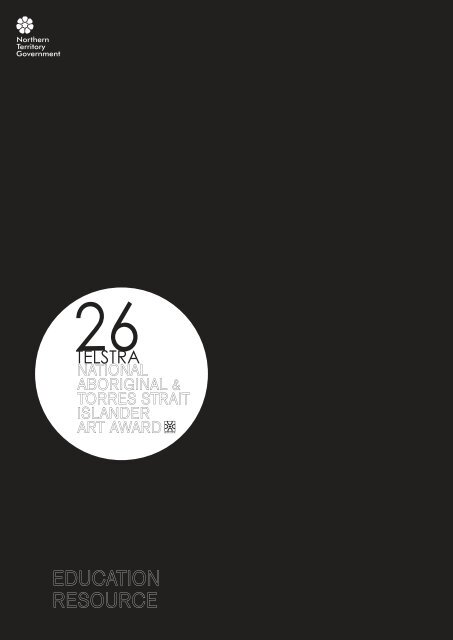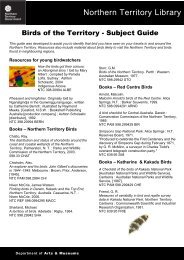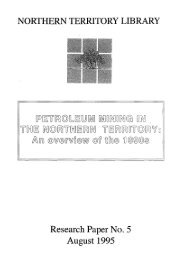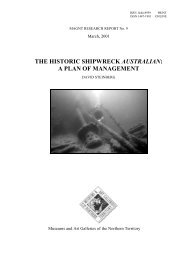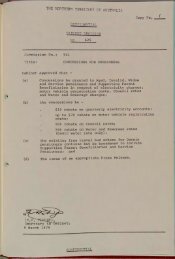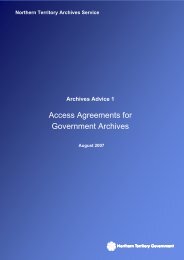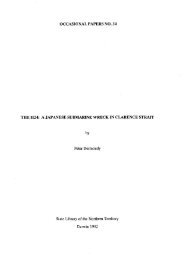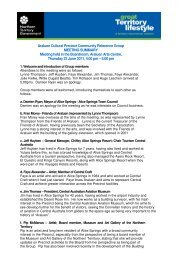EDUCATION RESOURCE - Department of Arts and Museums
EDUCATION RESOURCE - Department of Arts and Museums
EDUCATION RESOURCE - Department of Arts and Museums
- No tags were found...
Create successful ePaper yourself
Turn your PDF publications into a flip-book with our unique Google optimized e-Paper software.
26th NATSIAA Online Education Resource 2009<strong>EDUCATION</strong><strong>RESOURCE</strong>Museum <strong>and</strong> Art Gallery Northern Territory www.magnt.nt.gov.au Conacher Street, Fannie Bay NT 08201
26th NATSIAA Online Education Resource 2009ONLINE<strong>EDUCATION</strong><strong>RESOURCE</strong>IntroductionThere are many intersecting themes running throughout this exhibition <strong>and</strong> the artworks can beappreciated <strong>and</strong> discussed around a variety <strong>of</strong> selected works.This resource supports the Northern Territory Curriculum Framework with suggested activities forThe <strong>Arts</strong> Learning Area.The 26th Telstra National Aboriginal & Torres Strait Isl<strong>and</strong>er Art Award (NATSIAA) EducationResource focuses on four themes to stimulate thought <strong>and</strong> discussion:1. Art Awards <strong>and</strong> their Role2. Desert Painting / Arnhem L<strong>and</strong> Painting3. Looking Out – The Cosmos4. Animals in ArtThe aims <strong>of</strong> the education resource are to:• Stimulate thought <strong>and</strong> discussion by both teachers <strong>and</strong> students,• encourage engagement <strong>and</strong> response using selected artworks,• introduce broad examples <strong>and</strong> perceptions <strong>of</strong> Indigenous art practices, <strong>and</strong>• link themes <strong>and</strong> ideas in Australian Indigenous culture <strong>and</strong> art with those in mainstreamAustralia.Please visit the 26th Telstra NATSIAA Online Exhibition, www.magnt.nt.gov.au/natsiaaPrevious Online Education Resources are also available from the Learn <strong>and</strong> Discover section <strong>of</strong>our website. These resources can provide other thematic areas for teachers <strong>and</strong> studentsto explore.Museum <strong>and</strong> Art Gallery Northern Territory www.magnt.nt.gov.au Conacher Street, Fannie Bay NT 08202
26th NATSIAA Online Education Resource 2009ART AWARDSAND THEIR ROLEThere has been a major shift in the way Indigenous Australian art has been viewed overrecent decades. The art, while sustaining cultural values for communities, now has worldwideappreciation <strong>and</strong> commercial value.<strong>Museums</strong>, such as the Museum <strong>and</strong> Art Gallery <strong>of</strong> the Northern Territory, through exhibitions,awards, collection <strong>and</strong> conservation provide provenance, context <strong>and</strong> safe - keeping forartworks. The Telstra National Aboriginal & Torres Strait Isl<strong>and</strong>er Art Award (NATSIAA) provides vitalconduits that link artists <strong>and</strong> the public through exhibitions where artworks can be viewed <strong>and</strong>appreciatedTelstra NATSIAA, now in its 26th year, is one <strong>of</strong> Australia’s most celebrated art awards <strong>and</strong> attractshundreds <strong>of</strong> entries from all over Australia. A selection <strong>of</strong> these works are short-listed for theexhibition from which the prize-winners are chosen. Selection for inclusion in the Art Award canbe pivotal in launching an artist’s career.The prize categories, sponsored by Telstra, are:• Telstra Award ($40,000)• General Painting Award ($4,000)• Bark Painting Award ($4,000)• Work on Paper Award ($4,000)• W<strong>and</strong>juk Marika 3D Memorial Award ($4,000)The three artists in this section are all past winners <strong>of</strong> Telstra NATSIAA prizes. This section exploresthe role <strong>of</strong> the exhibition in providing context for the artworks.• Makinti Napanangka, Untitled, synthetic polymer paint on linenMakinti Napanangka is a senior artist from Kintore in the western desert <strong>of</strong> the NorthernTerritory. Napanangka works within the Papunya Tula artistic tradition. She has beenexhibiting since the mid-1990s <strong>and</strong> her work can be found in major collections throughoutAustralia. The designs in her paintings are associated with Dreamtime travels around herhomel<strong>and</strong> Kintore. Makinti previously won the Telstra Award, 25th Telstra NATSIAA 2008.• Dorothy Napangardi, Salt on Mina Mina, synthetic polymer paint on linenNapangardi’s work is concerned with a sacred site in the Tanami Desert that consists <strong>of</strong>large soaks associated with women’s ceremony. Napangardi has been exhibiting sincethe early 1990s. Her works exemplify an innovative approach to depicting l<strong>and</strong>scape <strong>and</strong>are pivotal in showcasing the diversity <strong>of</strong> Western Desert painting. Napangardi previouslywon the Telstra Award,18th Telstra NATSIAA 2001.• Ian W. Abdulla, Picking Grapes in My Younger Years, synthetic polymer paint on canvasIan Abdulla paints stories from his life living along the Murray River in South Australia. Bornin 1947, Abdulla’s works have been collected by major museums around Australia <strong>and</strong>shown throughout Australia <strong>and</strong> overseas. Abdulla previously won the Telstra GeneralPainting Award, 13th Telstra NATSIAA 1996.Museum <strong>and</strong> Art Gallery Northern Territory www.magnt.nt.gov.au Conacher Street, Fannie Bay NT 08203
26th NATSIAA Online Education Resource 2009IMAGESMakinti Napanangka, Untitled, synthetic polymer paint on linenDorothy Napangardi, Salt on Mina Mina, synthetic polymer paint on linenIan W. Abdulla, Picking Grapes in My Younger Years, synthetic polymer paint on canvasMuseum <strong>and</strong> Art Gallery Northern Territory www.magnt.nt.gov.au Conacher Street, Fannie Bay NT 08204
26th NATSIAA Online Education Resource 2009Primary YearsAt the exhibition: Art Responses & Analysis• Find the artwork that won the major award. Do you agree with the Judges’ choice? If not,who do you think should have won?• Notice how each artwork has an accompanying object label that provides information onthe artwork. What type <strong>of</strong> information is provided?• Read the story on Ian Abdulla’s painting. What job did Ian have in his younger years? Arethere any other paintings similar in a style to his work?At school or at home: Creating Art Ideas<strong>Arts</strong> Skills & Processes• Create your own art exhibition at school with object labels for your artworks; you mayeven want to award some prizes.• Create a wall display <strong>of</strong> pictures from magazines etc <strong>of</strong> artworks <strong>and</strong> group themaccording to theme, style, country <strong>of</strong> origin or period.• Exhibitions are put together by a curator. What type <strong>of</strong> things do you think the curatorhas to do?• Construct a model <strong>of</strong> a museum using cardboard. Attach artworks to the gallery walls.Curators use models to help them plan exhibitions.Middle YearsAt the exhibition: Art Responses & Analysis<strong>Arts</strong> in Context• There are many different types <strong>of</strong> art in the exhibition; how many can you find? You mayfind photography, painting, drawing, sculpture <strong>and</strong> weaving, as well as others.• There are five prize categories in the exhibition. Identify all the winning works. Make up anew prize category <strong>and</strong> choose a winner.• Why is it important not to touch the artworks <strong>and</strong> why do you think you shouldn’tphotograph the artworks?• After visiting the 26th Telstra NATSIAA exhibition visit the Indigenous Art gallery. Can youfind artists that have works in both the 26th Telstra NATSIAA <strong>and</strong> the Indigenous Art gallery?At school or at home: Creating Art Ideas<strong>Arts</strong> Skills & Processes• Search the internet to find artists from the Art Award. Look for their CVs (CurriculumVitaes). What information can you find out about the artists from their CV. Create yourown CV. What would you include that will tell your story?• Collect <strong>and</strong> analyse articles on the 26th Telstra NATSIAA. The Museum has informationonline about the award. You can also source articles from newspapers, art magazines, theinternet etc. Create a list <strong>of</strong> key words or phrases that are used to describe the Award inthese articles. Write your own review <strong>of</strong> the Art Award.Museum <strong>and</strong> Art Gallery Northern Territory www.magnt.nt.gov.au Conacher Street, Fannie Bay NT 08205
26th NATSIAA Online Education Resource 2009• Visit the Museum’s website at www.magnt.nt.gov.au/natsiaa <strong>and</strong> identify the major awardwinners going back to 2003.• Extend your knowledge on Indigenous artists by researching <strong>and</strong> writing an essay orcreating a poster on one <strong>of</strong> the winning artists. The Museum’s website is a goodstarting point.DESERT PAINTING /ARNHEM LAND PAINTINGThere is great diversity in the painting styles <strong>of</strong> Indigenous Australians in both technical <strong>and</strong>pictorial approaches. In this section we will focus on some <strong>of</strong> the differences between desert <strong>and</strong>Arnhem L<strong>and</strong> painting.Contemporary desert painting is generally made from acrylic paint on canvas while ArnhemL<strong>and</strong> artists paint with ochre on bark. Desert painting evolved from body <strong>and</strong> s<strong>and</strong> painting whilein Arnhem L<strong>and</strong> painting was traditionally done on rocks as well as the body. The use <strong>of</strong> ochrepaint has been sustained in Arnhem L<strong>and</strong>, (although now on portable barks instead <strong>of</strong> on rocks).In the desert a shift from paints made from natural pigment to acrylic paints on canvashas occurred.Both groups <strong>of</strong> artists predominantly depict Dreamtime stories in their painting. In the desert thereare generally more recognisable forms <strong>of</strong> topographical elements, while in Arnhem L<strong>and</strong> artistshave shifted from central iconography to symbolic geometric designs. Both groups <strong>of</strong> paintershave an abstract <strong>and</strong> symbolic quality to their work. The dot designs in desert painting can belinked to the marks made by fingers pushing into the s<strong>and</strong>. Crosshatching, also known as rarrk inbark painting, has its origins in rock art <strong>and</strong> is applied with reed brushes.• Lydia Balbal, MartakuluLydia Balbal makes paintings with intense colours <strong>and</strong> dense dot-markings that depicther country <strong>and</strong> the journeys her ancestors made through it. This painting tells aDreamtime story relating to the creation <strong>of</strong> a soak. As a child Lydia <strong>and</strong> her family weresome <strong>of</strong> the last people to make contact with European Australians in the 1960s.• Angelina Pwerle, Bush PlumAngelina Pwerle paints expansive fields <strong>of</strong> dots with a limited palette <strong>of</strong> reds. Her worklinks vast spiritual elements including country, the cosmos, Dreamtime <strong>and</strong> the body.The influence <strong>of</strong> Indonesian batik on Utopia’s artists can be seen in the patterns in herpainting.• Emmanuel Wurrkidj, DilebangEmmanuel Wurrkidj geometric designs are painted with detailed crosshatching technique.His work exemplifies the contemporary shift from iconic X-ray images to nonfigurativegeometric fields <strong>of</strong> crosshatching. The artist paints on prepared bark with ochre paintsapplied with reed-brushes. The painting expresses the power <strong>of</strong> dangerous sacred sitesnear escarpment country in Arnhem L<strong>and</strong>.Museum <strong>and</strong> Art Gallery Northern Territory www.magnt.nt.gov.au Conacher Street, Fannie Bay NT 08206
26th NATSIAA Online Education Resource 2009• John Bulunbulun - BakarraJohn Bulunbulun has been painting classic barks since the early 1970s. His approachto bark painting is more traditional than other central Arnhem L<strong>and</strong> painters as hestill maintains central iconography. In this painting Bakarra he represents sacredstone country. Bulunbulun previously won the W<strong>and</strong>juk Marika 3D Memorial Award(sponsored by Telstra),18th Telstra NATSIAA 2001.Museum <strong>and</strong> Art Gallery Northern Territory www.magnt.nt.gov.au Conacher Street, Fannie Bay NT 08207
26th NATSIAA Online Education Resource 2009IMAGESLydia Balbal, Martakulu, syntheticpolymer paint on linenAngelina Pwerle, Bush Plum, syntheticpolymer paintEmmanuel Wurrkidj, Dilebang,natural pigments on barkJohn Bulunbulun, Bakarra, naturalpigments on barkMuseum <strong>and</strong> Art Gallery Northern Territory www.magnt.nt.gov.au Conacher Street, Fannie Bay NT 08208
26th NATSIAA Online Education Resource 2009Primary YearsAt the exhibition: Art Responses & Analysis• Identify <strong>and</strong> discuss the differences between what Balbal <strong>and</strong> Wurrkidj have made theirpaintings on. Do you have a preference?• Can you see the bush plum flowers blooming in the desert in Pwerle’s painting? Trysquinting your eyes.• Balbal has painted a soak in the Great S<strong>and</strong>y Desert <strong>of</strong> Western Australia. Look at theshapes <strong>and</strong> colours in her painting: what features <strong>of</strong> the desert can you see? You may finda soak, s<strong>and</strong>-dunes, spinifex, rocks or a road.• Read the object label for Bulunbulun’s bark, what do the dots in the black lines represent?You will find another John Bulunbulun painting in the Gallery <strong>of</strong> Indigenous Art.At school or at home: Creating Art Ideas<strong>Arts</strong> Skills & Processes• Experiment with painting by using grass, reeds or similar implements as paintbrushes. Youmay extend this to explore bark as a surface to paint on (remember not to damage anytrees). You could also grind your own pigments <strong>and</strong> mix them with a binder such as glue tomake paint.• Create a painting using your fingers to make dot patterning; you could also make adesign in the s<strong>and</strong> (the beach would be a good place). In doing so you will be exploringthe beginning <strong>of</strong> the techniques used by many desert painters.• Much <strong>of</strong> the work in the 26th Telstra NATSIAA is concerned with l<strong>and</strong>scape <strong>and</strong> people’srelationship to it. Create an artwork about your relationship to a l<strong>and</strong>scape.• Bark painting has a strong emphasis on geometric design. Think about Wurrkidj’s painting<strong>of</strong> sacred country. Use shapes, patterns <strong>and</strong> other geometric elements to create anartwork depicting a l<strong>and</strong>scape. Look at the isobars on weather maps or thetopographical lines on a geographical map for inspiration.Middle YearsAt the exhibition: Art Responses & Analysis<strong>Arts</strong> in Context• Analyse the materials used by Wurrkidj <strong>and</strong> Bulunbulun. How do these reflect theenvironments they come from? Which <strong>of</strong> these two paintings best reflect an X-ray style<strong>of</strong> art?• Respond to one <strong>of</strong> the desert canvases that you like. Why do you like it <strong>and</strong> what makesit an effective painting from your view point? St<strong>and</strong> in front <strong>of</strong> your favourite <strong>and</strong> shareyour opinion.• Interpret Pwerle’s painting Bush Plum. Why would bush plums be important to the artist?How does this painting change if you view it close up compared with far away? Whatdoes the painting make you think <strong>of</strong>? Identify the colours <strong>and</strong> types <strong>of</strong> mark making. If youwere to paint an important food what would it be?• The four artworks in this section depict l<strong>and</strong>scape. Compare <strong>and</strong> discuss the differentapproaches between desert <strong>and</strong> Arnhem L<strong>and</strong> painters.Museum <strong>and</strong> Art Gallery Northern Territory www.magnt.nt.gov.au Conacher Street, Fannie Bay NT 08209
26th NATSIAA Online Education Resource 2009At school or at home: Creating Art Ideas<strong>Arts</strong> Skills & ProcessesArt Responses & Analysis• On a map <strong>of</strong> the Northern Territory or Australia identify both Arnhem L<strong>and</strong> <strong>and</strong> the desertregions; try to locate the artists’ homel<strong>and</strong>s.• Many Indigenous Australian painters represent l<strong>and</strong>scape <strong>and</strong> stories in an abstractmanner. Look at some <strong>of</strong> the famous Western painters for comparison; Jackson Pollack’sBlue Poles is a good example. Create your own abstract painting. Analyse your artwork.What were you responding to <strong>and</strong> how do you articulate your response in this work.• Examine the role <strong>of</strong> female artists in desert painting. Why does there appear to be morefemale painters in the desert than in Arnhem L<strong>and</strong>?• Research the impact <strong>of</strong> Indonesian Batik on Utopian artists. How have the designsassociated with batik influenced artists form Utopia?LOOKING OUT –THE COSMOSLooking out into the night’s sky <strong>and</strong> finding meaning in the wonderment <strong>of</strong> the cosmos haspreoccupied cultures throughout the world <strong>and</strong> has been the genesis <strong>of</strong> much art <strong>and</strong> manystories throughout the world.Indigenous Australian artists engage with their environment both physically <strong>and</strong> spiritually. Theirview <strong>of</strong> the l<strong>and</strong> is <strong>of</strong>ten expansive <strong>and</strong> transcends time, merging creation myths <strong>and</strong> legends.The influence <strong>of</strong> the cosmos for Australian Indigenous mythology is substantial <strong>and</strong> many artworksdepict associated stories <strong>and</strong> beliefs.• Gulumbu Yunupingu, GarakGulumbu paints the stars <strong>of</strong> the universe. She was introduced, through her father, toa Western view <strong>of</strong> the universe by a scientist working at a satellite tracking stationin western Arnhem L<strong>and</strong>. Gulumbu merges a Western <strong>and</strong> Yolngu view <strong>of</strong> the universe inher painting <strong>and</strong> sculpture. Yunupingu won the Telstra Award, 21st Telstra NATSIAA 2004• Gali Yalkarriwuy, BanumbirrBanumbirr is the brightest star that crosses the sky each night from east to west, crossingthe artist’s country. The star signifies the cycle <strong>of</strong> life <strong>and</strong> is represented by white featureson top <strong>of</strong> the poles. The colours represent clan designs.• Dennis Nona, Baidam Aw KuikNona’s art narrates the ancient legends <strong>of</strong> the Torres Strait Isl<strong>and</strong>s. Baidam in Torres Straitmeans shark <strong>and</strong> refers to the shark constellation used by Torres Strait Isl<strong>and</strong>er traders tonavigate. The ornamented human skull, once a prized trading item, has been engravedwith the shark constellation. Nona won the Telstra Award, 24th Telstra NATSIAA 2007Museum <strong>and</strong> Art Gallery Northern Territory www.magnt.nt.gov.au Conacher Street, Fannie Bay NT 082010
26th NATSIAA Online Education Resource 2009IMAGESGulumbu Yunupingu, Garak,natural pigments on barkGali Yalkarriwuy, Banumbirr, natural pigments,feathers, woodDennis Nona, Baidam Aw Kuik, cast bronze, pearl shell, fibreMuseum <strong>and</strong> Art Gallery Northern Territory www.magnt.nt.gov.au Conacher Street, Fannie Bay NT 082011
26th NATSIAA Online Education Resource 2009Primary YearsAt the exhibition:Art Responses & Analysis• Describe the markings on Gulumbu’s painting. Do her marks look like the stars in thenight sky?• Find the white feathers on top <strong>of</strong> Yalkarriwuy’s morning-star poles. Why do you think thereare nine poles? What type <strong>of</strong> birds do you think the feathers came from?• Use simple art language to tell how you feel about Nona’s skull Baidam. Can you find anyother skulls in artworks near by?• Find other artworks in the exhibition that look like the cosmos to you.At school or at home: Creating Art Ideas<strong>Arts</strong> Skills & Processes• Use paint or another suitable medium to create a painting <strong>of</strong> our solar system.• Thinking about Nona’s skull <strong>and</strong> the star constellation on it, draw the constellation <strong>of</strong> yourzodiac sign on a 3D object.• Create sculptural poles that incorporate social issue symbols from recycled materials. Lookat Yalkarriwuy’s poles for inspiration.• Create a dot-to-dot activity using stars instead <strong>of</strong> numbers to form a picture <strong>of</strong> yourfavourite animal.Middle YearsAt the exhibition: Art Responses & Analysis<strong>Arts</strong> in Context• Prepare flash cards with the names <strong>of</strong> the three artists in this section prior to visiting theexhibition. Using the cards, find the works <strong>of</strong> these artists.• Read the object label for Yalkarriwuy’s Banumbirr. What star or planet do you thinkBanumbirr is?• Identify the various materials in Yalkarriwuy’s poles. You will find another three morning starpoles in the Gallery <strong>of</strong> Indigenous Art.• The traditional trading item in the Torres Strait Isl<strong>and</strong>s was human skulls. What items todaymight be traded instead <strong>of</strong> human skulls? What purpose today do these sculptured skullshave, now that real skulls are no longer traded?Museum <strong>and</strong> Art Gallery Northern Territory www.magnt.nt.gov.au Conacher Street, Fannie Bay NT 082012
26th NATSIAA Online Education Resource 2009At school or at home: Creating Art Ideas<strong>Arts</strong> Skills & Processes• Yalkarriwuy creates sculptural poles that tell stories about his community. He incorporatesobjects <strong>and</strong> designs into the poles to signify <strong>and</strong> narrate important elements <strong>of</strong> his family<strong>and</strong> community. Using found sticks apply paint <strong>and</strong> other found natural objects to makeyour own morning star pole.• Explore <strong>and</strong> research ways other cultures represent the cosmos. Find a pop song that hassomething from the cosmos in its lyrics. How does the songwriter describe the cosmos. Ifyou read the lyrics rather than listen to them how does that change your perception <strong>of</strong>the song.• Design <strong>and</strong> produce a collective class display <strong>of</strong> the stars with each student contributinga model <strong>of</strong> their zodiac symbol. Suspend all <strong>of</strong> them from the ceiling.• Make sketches <strong>of</strong> the night sky. Use these sketches to create a story.ANIMALSIN ARTThe incorporation <strong>of</strong> animals into artworks is practiced by all cultures. Some <strong>of</strong> the earliestcave art ever made by Paleolithic people depict scenes <strong>of</strong> animals being hunted. IndigenousAustralians include animals in their art <strong>and</strong> stories for a number <strong>of</strong> reasons. Animals in human formare the protagonists in Dreamtime creation stories, a major food source <strong>and</strong> a constant in theenvironment.• Owen Yal<strong>and</strong>ja, Yawkyawk Spirit FigureYawkyawks are important female water spirits that can be compared to mermaids.In the Dreamtime animals were humans <strong>and</strong> they created all the animals, plants <strong>and</strong>l<strong>and</strong>scapes we see today. Yal<strong>and</strong>ja carves yawkyawks from wood <strong>and</strong> paints designson them.• Graham Badari, Namarlpe (P<strong>and</strong>anus Spirit) & Kuluban (Fruit bats)Badari’s bark painting uses classic X-ray style to illustrate the story <strong>of</strong> a bad p<strong>and</strong>anus spirit<strong>and</strong> a group <strong>of</strong> sleeping fruit bats that are considered good eating.• Marina Murdilnga, ButterflyMurdilnga’s woven butterfly is made in classic style using natural dyes <strong>and</strong> p<strong>and</strong>anus.There is an ongoing tradition, primarily by women, <strong>of</strong> weaving useful objects such as fishtraps,baskets <strong>and</strong> mats from natural materials. In this instance the artist has produced asecular object merging the beauty <strong>of</strong> woven form with that <strong>of</strong> a butterfly form.Museum <strong>and</strong> Art Gallery Northern Territory www.magnt.nt.gov.au Conacher Street, Fannie Bay NT 082013
26th NATSIAA Online Education Resource 2009IMAGESGraham Badari, Namarlpe, (P<strong>and</strong>anus Spirit) &Kuluban (Fruit bats), natural pigment on barkOwen Yal<strong>and</strong>ja, Yawkyawk SpiritFigure, natural pigment on woodMarina Murdilnga, Butterfly,p<strong>and</strong>anus, natural dyesMuseum <strong>and</strong> Art Gallery Northern Territory www.magnt.nt.gov.au Conacher Street, Fannie Bay NT 082014
26th NATSIAA Online Education Resource 2009Primary YearsAt the exhibition: Art Responses & Analysis• Can you find the mermaid sculptures? How do the marks on these sculptures comparewith those <strong>of</strong> the bark paintings?• When exploring the exhibition you will be able to find many different animals. Whatanimals can you find?• In Badari’s bark painting you will notice a group <strong>of</strong> sleeping fruit bats. How many fruit batscan you count? Would you like to eat a delicious fruit bat for dinner?• Describe the shapes in Murdilnga’s Butterfly. Identify the parts <strong>of</strong> the butterfly i.e. wings,body, antennae etc. What material has the artist used to make Butterfly? Is it a sculptureor a painting?At school or at home: Creating Art Ideas<strong>Arts</strong> Skills & Processes• Draw how you think a mermaid looks. Draw other animals that have similar features toa mermaid.• Create a collage <strong>of</strong> your favourite animal or pet.• Learn about X-ray style art by drawing the outline <strong>of</strong> an animal <strong>and</strong> filling in its organs,bones etc. Can you find some real X-rays to look at?• Use an old metal coat hanger to form the outline <strong>of</strong> an animal <strong>and</strong> then wind string <strong>and</strong>other materials around it. Display in your class.Middle YearsAt the exhibition: Art Responses & Analysis<strong>Arts</strong> in Context• Describe the physical features <strong>of</strong> a mermaid. How do you say ‘mermaid’ in the artist’slanguage? Look on the object label.• Interpret Badari’s painting. Use your own ideas to tell what story is being told, read theobject label to see if you <strong>and</strong> the artist had the same story.• After viewing Murdilnga’s Butterfly visit the Gallery <strong>of</strong> Indigenous Art <strong>and</strong> identify otherwoven objects. Which ones have a practical use <strong>and</strong> which ones are purely aesthetic?• Take time to visit Transformations, the Museum’s gallery <strong>of</strong> natural history, where youwill find on display many <strong>of</strong> Northern Territory’s animals. Find <strong>and</strong> match animals inTransformations that feature in the artworks in the 26th Telstra NATSIAA.Museum <strong>and</strong> Art Gallery Northern Territory www.magnt.nt.gov.au Conacher Street, Fannie Bay NT 082015
26th NATSIAA Online Education Resource 2009At school or at home: Creating Art Ideas<strong>Arts</strong> Skills & Processes• What animals do you think look like mermaids? Using recycled materials make your ownsculpture <strong>of</strong> a mermaid.• Represent the animals in your school or backyard in an artwork.• Research <strong>and</strong> learn weaving techniques used in the Top End <strong>and</strong> create artworks <strong>and</strong>utilitarian objects. Select a native animal. How would you depict this animal in a 3dartwork? Would this artwork have a utilitarian purpose?• What important idea did Charles Darwin have about the creation <strong>of</strong> animals? Whatis similar <strong>and</strong> what is different about Charles Darwin’s ideas <strong>and</strong> those <strong>of</strong> IndigenousAustralians? You could extend this to compare other beliefs about creation.Museum <strong>and</strong> Art Gallery Northern Territory www.magnt.nt.gov.au Conacher Street, Fannie Bay NT 082016


